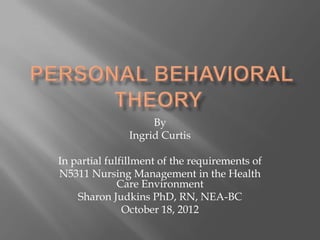
LEADERSHIP Behavioral Theory Explained
- 1. By Ingrid Curtis In partial fulfillment of the requirements of N5311 Nursing Management in the Health Care Environment Sharon Judkins PhD, RN, NEA-BC October 18, 2012
- 2. Behavioral theories of leadership are based upon the belief that great leaders are made, not born. (Cherry 2010). This leadership theory focuses on the actions of leaders. According to this theory, people can learn to become leaders through teaching and observation. The 'behavioral ideals' approach argues that if a leader is to be effective, he or she should practice a certain ideal behavioral style. The Behavioral theory assumes that you can learn to become a good leader because you are not drawing on personality traits. Your actions—what you do—define your leadership ability. STARS ARE CREATED, NOT BORN!
- 3. Tools that are used to assess the leader's style, and most commonly used, are the LBDQ (Leader Behavior Description Questionnaire), (Stogdill, 1974) and the Leadership Grid (Blake & McCanse, 1991). These tools are designed to be completed by the observers or the employees. The leaders themselves complete the LOQ (Leader Opinion Questionnaire).
- 4. Strengths: Weaknesses: The 'ideal' approach may not It makes sense for suit all circumstances. leaders to balance Many leaders' behavioral concern for the task patterns are restricted by with concern for people hidden limiting beliefs that persist despite training. in most circumstances. Ignores leadership presence. Training in the ideal Behavioral questionnaires style should be possible often introduce several types of error, such as response in theory. bias and measurement bias. (Yukl, 1998)
- 5. It is not a refined theory that has organized sets of prescriptions for effective leadership. It provides a framework for assessing effective leadership. It works by describing to leaders the major components of their behavior and NOT by telling them how to behave. It reminds leaders that their actions towards others are both at the task and relationship levels. In some situations task behavior is more appropriate, in others relationship is more suitable. Similarly, some subordinates need leaders who provide a lot of direction. Others need a lot of support and nurturance.
- 6. The behavioral approach can be easily applied in organizations. It provides a mirror for managers that helps them understand, how they are performing as a manager. This theory will help you focus on how you behave today and the dominant leadership style you adopt. You will be able to identify differences in your leadership style and approach to more effective combinations that balance and combine a focus on people and production.
- 7. I would recommend the use of this theory for the purpose to explain how leaders can combine these two kinds of behaviors to influence their employees to reach a goal. Task behavior: Facilitates goal accomplishment. Relationship behavior: Help subordinates feel comfortable with themselves, with others and with the situation.
- 8. Blake and McCanse Leadership Grid: Improve your leadership style and leadership skills. Retrieved on Oct 15, 2012, from: http://www.iwise2.com/blake-mouton-mccanse- leadership-grid Cherry, K. 2010, Leadership Theories-8 Major Leadership Theories, online, retrieved 17October 2012, from : http://psychology.about.com/od/leadership/p/leadtheories.h tm Stogdill, R. M. (1974). Handbook of leadership. New York: Free Press. Yukl, G. (1998), Journal of Management: Managerial Leadership, A Review of Theory and Research, June 1989, Vol. 15, no. 2, pgs 251-289. doi: 10.1177/014920638901500207
Notas del editor
- Personal Behavioral Theories– Presented by Ingrid Curtis
- The behavioral theory is a leadership theory that considers the observable actions and reactions of leaders and followers in a given situation. STARS ARE CREATED, NOT BORN.
- The use of these tools helps to identify the leader’s style and the responses that they receive from their employees or subordinates. These tools are used to determine the effectiveness of their behavioral style of leadership.
- Strengths :It broadened the scope of leadership research to include the behaviors of leaders and what they do in various situations.A wide range of studies on leadership style validates and gives credibility to the basic tenets of this approach.The style approach has ascertained that a leader’s style is composed of primarily two major types of behavior: task and relationship. The style approach is heuristic: it provides us a broad conceptual map that is worth using in our attempts to understand the complexity of leadership. Weakness : The research on styles has not adequately shown, how leaders´ styles are associated with performance outcomes (Yukl 1994). It has failed to find a universal style of leadership that could be effective in almost every situation .It implies that the most effective leadership style is the high task and high relationship style .(Blake and McCanse 1991) when the research findings provide only limited support for a universal high-high style (Yukl 1998).
- It is said that, “the test of a leader lies in the reaction and response of his followers. He should not have to impose authority. Bossiness in itself never made a leader. He must makehis influence felt by example and the instilling of confidence in his followers. The greatness of a leader is measured by the achievements of the led. This isthe ultimate test of his effectiveness.GEN Omar Bradley
- I would define leadership as influencing people by providing purpose, direction, and motivation, while operating to accomplish the mission and improve the organization.
- Use of Behavioral Theory for Task Behavior, which helps employees accomplish goals. Relationship behavior is useful for helping employees feel comfortable with themselves, others and the situation.
- Thank you for your time. Are there any questions?